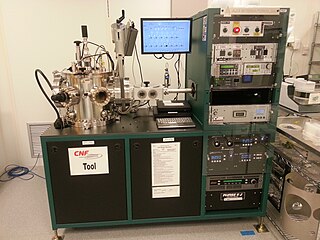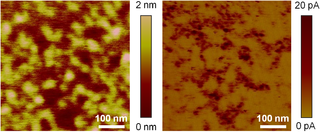Related Research Articles

Chemical vapor deposition (CVD) is a vacuum deposition method used to produce high-quality, and high-performance, solid materials. The process is often used in the semiconductor industry to produce thin films.

MEMS is the technology of microscopic devices incorporating both electronic and moving parts. MEMS are made up of components between 1 and 100 micrometres in size, and MEMS devices generally range in size from 20 micrometres to a millimetre, although components arranged in arrays can be more than 1000 mm2. They usually consist of a central unit that processes data and several components that interact with the surroundings.

Semiconductor device fabrication is the process used to manufacture semiconductor devices, typically integrated circuits (ICs) such as computer processors, microcontrollers, and memory chips. It is a multiple-step photolithographic and physico-chemical process during which electronic circuits are gradually created on a wafer, typically made of pure single-crystal semiconducting material. Silicon is almost always used, but various compound semiconductors are used for specialized applications.

In physics, sputtering is a phenomenon in which microscopic particles of a solid material are ejected from its surface, after the material is itself bombarded by energetic particles of a plasma or gas. It occurs naturally in outer space, and can be an unwelcome source of wear in precision components. However, the fact that it can be made to act on extremely fine layers of material is utilised in science and industry—there, it is used to perform precise etching, carry out analytical techniques, and deposit thin film layers in the manufacture of optical coatings, semiconductor devices and nanotechnology products. It is a physical vapor deposition technique.
In the semiconductor industry, the term high-κ dielectric refers to a material with a high dielectric constant, as compared to silicon dioxide. High-κ dielectrics are used in semiconductor manufacturing processes where they are usually used to replace a silicon dioxide gate dielectric or another dielectric layer of a device. The implementation of high-κ gate dielectrics is one of several strategies developed to allow further miniaturization of microelectronic components, colloquially referred to as extending Moore's Law.

Hafnium(IV) chloride is the inorganic compound with the formula HfCl4. This colourless solid is the precursor to most hafnium organometallic compounds. It has a variety of highly specialized applications, mainly in materials science and as a catalyst.
Atomic layer deposition (ALD) is a thin-film deposition technique based on the sequential use of a gas-phase chemical process; it is a subclass of chemical vapour deposition. The majority of ALD reactions use two chemicals called precursors. These precursors react with the surface of a material one at a time in a sequential, self-limiting, manner. A thin film is slowly deposited through repeated exposure to separate precursors. ALD is a key process in fabricating semiconductor devices, and part of the set of tools for synthesizing nanomaterials.
Plasma etching is a form of plasma processing used to fabricate integrated circuits. It involves a high-speed stream of glow discharge (plasma) of an appropriate gas mixture being shot at a sample. The plasma source, known as etch species, can be either charged (ions) or neutral. During the process, the plasma generates volatile etch products at room temperature from the chemical reactions between the elements of the material etched and the reactive species generated by the plasma. Eventually the atoms of the shot element embed themselves at or just below the surface of the target, thus modifying the physical properties of the target.

Plasma cleaning is the removal of impurities and contaminants from surfaces through the use of an energetic plasma or dielectric barrier discharge (DBD) plasma created from gaseous species. Gases such as argon and oxygen, as well as mixtures such as air and hydrogen/nitrogen are used. The plasma is created by using high frequency voltages to ionise the low pressure gas, although atmospheric pressure plasmas are now also common.

Hafnium(IV) oxide is the inorganic compound with the formula HfO
2. Also known as hafnium dioxide or hafnia, this colourless solid is one of the most common and stable compounds of hafnium. It is an electrical insulator with a band gap of 5.3~5.7 eV. Hafnium dioxide is an intermediate in some processes that give hafnium metal.
Resistive random-access memory is a type of non-volatile (NV) random-access (RAM) computer memory that works by changing the resistance across a dielectric solid-state material, often referred to as a memristor. One major advantage of ReRAM over other NVRAM technologies is the ability to scale below 10 nm.
High-power impulse magnetron sputtering is a method for physical vapor deposition of thin films which is based on magnetron sputter deposition. HIPIMS utilises extremely high power densities of the order of kW⋅cm−2 in short pulses (impulses) of tens of microseconds at low duty cycle of < 10%. Distinguishing features of HIPIMS are a high degree of ionisation of the sputtered metal and a high rate of molecular gas dissociation which result in high density of deposited films. The ionization and dissociation degree increase according to the peak cathode power. The limit is determined by the transition of the discharge from glow to arc phase. The peak power and the duty cycle are selected so as to maintain an average cathode power similar to conventional sputtering (1–10 W⋅cm−2).
AVS: Science and Technology of Materials, Interfaces, and Processing is a not-for-profit learned society founded in 1953 focused on disciplines related to materials, interfaces, and processing. AVS has approximately 4500 members worldwide from academia, governmental laboratories and industry.

A slot-waveguide is an optical waveguide that guides strongly confined light in a subwavelength-scale low refractive index region by total internal reflection.

In microscopy, conductive atomic force microscopy (C-AFM) or current sensing atomic force microscopy (CS-AFM) is a mode in atomic force microscopy (AFM) that simultaneously measures the topography of a material and the electric current flow at the contact point of the tip with the surface of the sample. The topography is measured by detecting the deflection of the cantilever using an optical system, while the current is detected using a current-to-voltage preamplifier. The fact that the CAFM uses two different detection systems is a strong advantage compared to scanning tunneling microscopy (STM). Basically, in STM the topography picture is constructed based on the current flowing between the tip and the sample. Therefore, when a portion of a sample is scanned with an STM, it is not possible to discern if the current fluctuations are related to a change in the topography or to a change in the sample conductivity.
Ultra-high-temperature ceramics (UHTCs) are a type of refractory ceramics that can withstand extremely high temperatures without degrading, often above 2,000 °C. They also often have high thermal conductivities and are highly resistant to thermal shock, meaning they can withstand sudden and extreme changes in temperature without cracking or breaking. Chemically, they are usually borides, carbides, nitrides, and oxides of early transition metals.
Richard Magee Osgood Jr. was an American applied and pure physicist. He was Higgins Professor of Electrical Engineering and Applied Physics at Columbia University.
Alan T. Charlie Johnson is an American physicist and a professor in physics and astronomy at the University of Pennsylvania. Johnson currently serves as the founding executive editor of the scientific journal AIP Advances and the co-founder of Graphene Frontiers, LLC.
Irving Philip Herman is an American physicist and the Edwin Howard Armstrong Professor of Applied Physics at Columbia University. He is an elected Fellow of the American Physical Society and of Optica, the former for "distinguished accomplishments in laser physics, notably the development and application of laser techniques to probe and control materials processing".
Hafnium compounds are compounds containing the element hafnium (Hf). Due to the lanthanide contraction, the ionic radius of hafnium(IV) (0.78 ångström) is almost the same as that of zirconium(IV) (0.79 angstroms). Consequently, compounds of hafnium(IV) and zirconium(IV) have very similar chemical and physical properties. Hafnium and zirconium tend to occur together in nature and the similarity of their ionic radii makes their chemical separation rather difficult. Hafnium tends to form inorganic compounds in the oxidation state of +4. Halogens react with it to form hafnium tetrahalides. At higher temperatures, hafnium reacts with oxygen, nitrogen, carbon, boron, sulfur, and silicon. Some compounds of hafnium in lower oxidation states are known.
References
- ↑ Chang, Jane Pei-chen (1998). Study of plasma-surface kinetics and simulation of feature profile evolution in chlorine etching of patterned polysilicon (Thesis). Massachusetts Institute of Technology. hdl:1721.1/50356. OCLC 39171343.
- 1 2 Ellis, Gordon (September 29, 2021). "Meet Some of AIChE's Recently Elected Fellows". www.aiche.org. American Institute of Chemical Engineers.
- 1 2 Chang, Jane P.; Lin, You-Sheng (2001-09-15). "Highly conformal ZrO2 deposition for dynamic random access memory application". Journal of Applied Physics. 90 (6). AIP Publishing: 2964–2969. doi:10.1063/1.1389756. ISSN 0021-8979.
- 1 2 Lin, Y.-S.; Puthenkovilakam, R.; Chang, J. P. (2002-09-09). "Dielectric property and thermal stability of HfO2 on silicon". Applied Physics Letters . 81 (11). AIP Publishing: 2041–2043. doi:10.1063/1.1506207. ISSN 0003-6951.
- 1 2 Tanner, Carey M.; Perng, Ya-Chuan; Frewin, Christopher; Saddow, Stephen E.; Chang, Jane P. (2007-11-12). "Electrical performance of Al2O3 gate dielectric films deposited by atomic layer deposition on 4H-SiC". Applied Physics Letters. 91 (20). AIP Publishing. doi:10.1063/1.2805742. ISSN 0003-6951.
- ↑ Bodderas, Elke (November 6, 2010). "Das Körnchen ist ein Akku" (in German). Berlin: Die Welt. ProQuest 762553092.
- ↑ "AVS Election Winners | Biography: Jane P. Chang". avs.org. Retrieved October 25, 2024.
- ↑ "Professor Jane Chang receives 2018 AVS Plasma Prize". UCLA Samueli Chemical & Biomolecular Engineering. November 7, 2018.
- ↑ "CAREER: Plasma and Surface Chemistry in Depositing and Etching Metal Oxides". www.nsf.gov. April 1, 2000. Retrieved October 23, 2024.
- ↑ "Fellow of the Society | List of Fellows". avs.org. AVS Science and Technology of Materials, Interfaces, and Processing . Retrieved October 23, 2024.
- ↑ "Plasma Science & Technology Division Plasma Prize | Past Winners". avs.org. AVS Science and Technology of Materials, Interfaces, and Processing . Retrieved October 23, 2024.